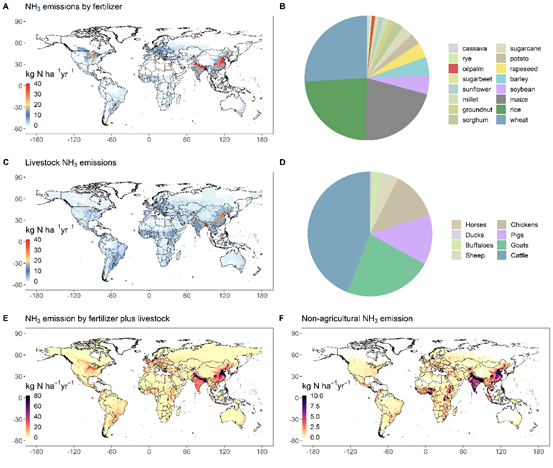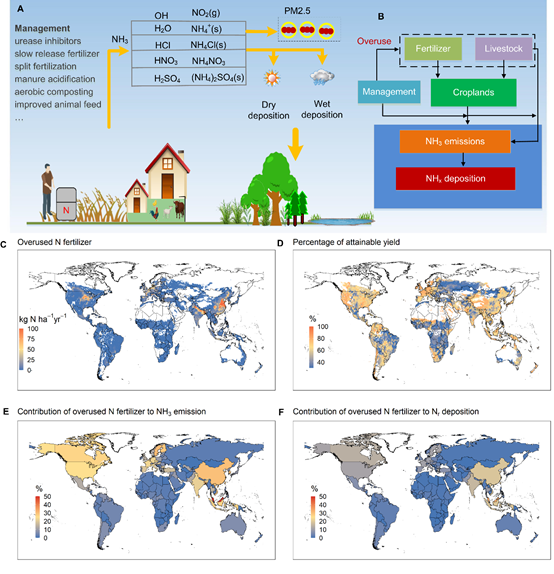Ammonia, as the main alkaline gas in the atmosphere, is not only an important contributor to PM2.5 pollution but also an important contributor to atmospheric nitrogen deposition. Atmospheric ammonia emissions are closely related to the excessive use of reactive nitrogen in agricultural production over the past few decades. However, it is not clear which crops or animals have high ammonia emission potential in the global agricultural system and how agricultural ammonia emissions affect the spatiotemporal patterns of global nitrogen deposition.
To solve these problems, the nitrogen cycle research team of the College of Resources and Environment, Lanzhou University established a bottom-up calculation approach for agricultural ammonia emissions based on multi-source geospatial data (including farmland fertilization, livestock breeding, remote sensing reactive nitrogen concentration, etc.) and regional statistics, and developed a global long-recorded agricultural ammonia emission dataset for nearly four decades (1980-2018). The study found that from 1980 to 2018, global ammonia emissions from agricultural systems (including cropland and livestock) increased by 78%, including a 128% increase from cropland and a 45% increase from livestock. Three major crops (wheat, maize, and rice) and four major animals (cattle, chickens, sheep, and pigs) account for more than 70% of total ammonia emissions globally (Figure 1).

Figure 1. Spatial distribution and main contribution sources of global agricultural ammonia emissions
Based on the constructed long time series agricultural ammonia emission dataset, the research team drove the global atmospheric chemistry model GEOS-Chem to systematically assess the impact of agricultural ammonia emissions on the spatial-temporal patterns of nitrogen deposition since 1980. The study found that the EU is the only region in the world where ammonia nitrogen deposition has decreased since 1980, with a decrease of about 16%. The main reason is that European Union has included ammonia emission control into the air pollution control policies and formulated a series of targeted agricultural ammonia emission reduction measures. However, with the exception of the European Union, most countries in the world have yet to strictly regulate ammonia emissions, resulting in a 72% increase in terrestrial ammonia-nitrogen deposition worldwide, with the proportion of ammonia-nitrogen deposition in total deposition increasing from 41% in 1980 to 54% in 2018.
Based on the yield-nitrogen fertilizer feedback relationship model, it was found that the global nitrogen fertilizer use could be reduced by 38% while maintaining the same yield of existing crops, with three major crops (wheat, maize, and rice) accounting for about 72% of excess nitrogen use (Figure 2). Overuse of nitrogen fertilizer accounted for 11% of ammonia emissions from agriculture (on-farm and livestock), and 31%, 25%, and 22% of agricultural ammonia emissions in China, India, and the United States, respectively. Nitrogen overuse accounts for 10% of total N deposition globally, with China, India, and the United States accounting for 10-20% of total N deposition in each country. In addition to planting, rational control of the animal husbandry system can further reduce agricultural ammonia emissions, such as acidification and ammonia suppression, closed ammonia control, recovery of solid ammonium, etc. Although Western European countries (such as Denmark and the Netherlands) have adopted agricultural nitrogen management measures and formulated ammonia emission control policies, China, India, the United States, and other countries still lack relevant policy support in solving agricultural ammonia pollution.

Figure 2. Contribution of nitrogen fertilizer overuse to agricultural ammonia emission and nitrogen deposition
This study quantifies the contributions of major crops and animal types to agricultural ammonia emissions at the global scale, answers the question of the main sources of ammonia emissions in the current agricultural systems, and provides important data support for an accurate understanding of global agricultural ammonia pollution. The study concludes that ammonia nitrogen will occupy a larger proportion of global nitrogen deposition in the future if the control of ammonia emission is not strengthened. This study provides an important scientific basis for policy formulation of agricultural ammonia pollution, which is of great significance for achieving the goal of the Colombo Declaration goal to reduce nitrogen pollution by half worldwide.
A related study, titled "Exploring global changes in agricultural ammonia emissions and their contribution to nitrogen deposition since 1980", was published online in PNAS journal on March 28, 2022 (https://www.pnas.org/doi/10.1073/pnas.2121998119). Researcher Liu Lei from Lanzhou University is the first author and corresponding author, and Prof. Liu Xuejun from China Agricultural University is the co-corresponding author. This paper is the integrated result of the research team's research on agricultural ammonia emission and atmospheric nitrogen deposition in the past five years. This study is a successful attempt at interdisciplinary cooperation between geography, atmospheric science, and ecology, and has important academic value for understanding the spatial and temporal patterns of atmospheric nitrogen deposition and the interconnection of agricultural ammonia emissions. This research was supported by the National Key Research and Development Program of China (2017YFC0210100 and 2017YFD0200101), the National Natural Science Foundation of China (42001347, 41471343, 41425007, 41705130, and 41922037), the Free Exploration Project of Central Universities of Lanzhou University, and the High-Level Team Building Project of China Agricultural University.
Link to article: https://www.pnas.org/doi/10.1073/pnas.2121998119.